
Lost-wax casting – also called investment casting, precision casting, or cire perdue (French: [siʁ pɛʁdy]; borrowed from French)[1] – is the process by which a duplicate sculpture (often a metal, such as silver, gold, brass, or bronze) is cast from an original sculpture. Intricate works can be achieved by this method.
The oldest known examples of this technique are approximately 6,500 years old (4550–4450 BC) and attributed to gold artefacts found at Bulgaria's Varna Necropolis.[2] A copper amulet from Mehrgarh, Indus Valley civilization, in Pakistan, is dated to circa 4,000 BC.[3] Cast copper objects, found in the Nahal Mishmar hoard in southern Israel, which belong to the Chalcolithic period (4500–3500 BC), are estimated, from carbon-14 dating, to date to circa 3500 BC.[4][5] Other examples from somewhat later periods are from Mesopotamia in the third millennium BC.[6] Lost-wax casting was widespread in Europe until the 18th century, when a piece-moulding process came to predominate.
The steps used in casting small bronze sculptures are fairly standardized, though the process today varies from foundry to foundry (in modern industrial use, the process is called investment casting). Variations of the process include: "lost mould", which recognizes that materials other than wax can be used (such as tallow, resin, tar, and textile);[7] and "waste wax process" (or "waste mould casting"), because the mould is destroyed to remove the cast item.[8][9]

Casts can be made of the wax model itself, the direct method, or of a wax copy of a model that need not be of wax, the indirect method. These are the steps for the indirect process (the direct method starts at step 7):
Prior to silica-based casting moulds, these moulds were made of a variety of other fire-proof materials, the most common being plaster based, with added grout, and clay based. Prior to rubber moulds gelatine was used.
The methods used for small parts and jewellery vary somewhat from those used for sculpture. A wax model is obtained either from injection into a rubber mould or by being custom-made by carving. The wax or waxes are sprued and fused onto a rubber base, called a "sprue base". Then a metal flask, which resembles a short length of steel pipe that ranges roughly from 3.5 to 15 centimeters tall and wide, is put over the sprue base and the waxes. Most sprue bases have a circular rim which grips the standard-sized flask, holding it in place. Investment (refractory plaster) is mixed and poured into the flask, filling it. It hardens, then is burned out as outlined above. Casting is usually done straight from the kiln either by centrifugal casting or vacuum casting.
The lost-wax process can be used with any material that can burn, melt, or evaporate to leave a mould cavity. Some automobile manufacturers use a lost-foam technique to make engine blocks. The model is made of polystyrene foam, which is placed into a casting flask, consisting of a cope and drag, which is then filled with casting sand. The foam supports the sand, allowing shapes that would be impossible if the process had to rely on the sand alone. The metal is poured in, vaporizing the foam with its heat.
In dentistry, gold crowns, inlays and onlays are made by the lost-wax technique. Application of Lost Wax technique for the fabrication of cast inlay was first reported by Taggart. A typical gold alloy is about 60% gold and 28% silver with copper and other metals making up the rest. Careful attention to tooth preparation, impression taking and laboratory technique are required to make this type of restoration a success. Dental laboratories make other items this way as well.
In this process, the wax and the textile are both replaced by the metal during the casting process, whereby the fabric reinforcement allows for a thinner model, and thus reduces the amount of metal expended in the mould.[10] Evidence of this process is seen by the textile relief on the reverse side of objects and is sometimes referred to as "lost-wax, lost textile". This textile relief is visible on gold ornaments from burial mounds in southern Siberia of the ancient horse riding tribes, such as the distinctive group of openwork gold plaques housed in the Hermitage Museum, Saint Petersburg.[10] The technique may have its origins in the Far East, as indicated by the few Han examples, and the bronze buckle and gold plaques found at the cemetery at Xigou.[11] Such a technique may also have been used to manufacture some Viking Age oval brooches, indicated by numerous examples with fabric imprints such as those of Castletown (Scotland).[12]
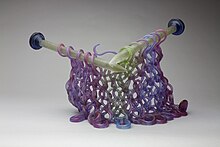
The lost-wax casting process may also be used in the production of cast glass sculptures. The original sculpture is made from wax. The sculpture is then covered with mold material (e.g., plaster), except for the bottom of the mold which must remain open. When the mold has hardened, the encased sculpture is removed by applying heat to the bottom of the mold. This melts out the wax (the wax is 'lost') and destroys the original sculpture. The mold is then placed in a kiln upside down with a funnel-like cup on top that holds small chunks of glass. When the kiln is brought up to temperature (1450-1530 degrees Fahrenheit), the glass chunks melt and flow down into the mold. Annealing time is usually 3–5 days, and total kiln time is 5 or more days. After the mold is removed from the kiln, the mold material is removed to reveal the sculpture inside.
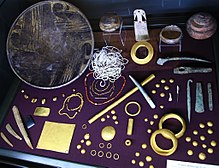
Cast gold knucklebones, beads, and bracelets, found in graves at Bulgaria's Varna Necropolis, have been dated to approximately 6500 years BP. They are believed to be both some of the oldest known manufactured golden objects, and the oldest objects known to have been made using lost wax casting.[2]

Some of the oldest known examples of the lost-wax technique are the objects discovered in the Nahal Mishmar hoard in southern Land of Israel, and which belong to the Chalcolithic period (4500–3500 BC). Conservative Carbon-14 estimates date the items to around 3700 BC, making them more than 5700 years old.[4][5]
In Mesopotamia, from c. 3500–2750 BC, the lost-wax technique was used for small-scale, and then later large-scale copper and bronze statues.[4] One of the earliest surviving lost-wax castings is a small lion pendant from Uruk IV. Sumerian metalworkers were practicing lost-wax casting from approximately c. 3500–3200 BC.[13] Much later examples from northeastern Mesopotamia/Anatolia include the Great Tumulus at Gordion (late 8th century BC), as well as other types of Urartian cauldron attachments.[14]
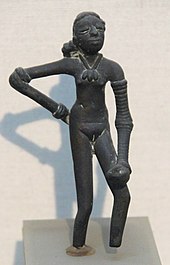
The oldest known example of applying the lost-wax technique to copper casting comes from a 6,000-year-old (c. 4000 BC) copper, wheel-shaped amulet found at Mehrgarh, Pakistan.[3]
Metal casting, by the Indus Valley civilization, produced some of the earliest known examples of lost-wax casting applied to the casting of copper alloys, a bronze figurine, found at Mohenjo-daro, and named the "dancing girl", is dated to 2300-1750 BCE.[15][16] Other examples include the buffalo, bull and dog found at Mohenjodaro and Harappa,[7][16][17] two copper figures found at the Harappan site Lothal in the district of Ahmedabad of Gujarat,[15] and likely a covered cart with wheels missing and a complete cart with a driver found at Chanhudaro.[7][17]
During the post-Harappan period, hoards of copper and bronze implements made by the lost-wax process are known from Tamil Nadu, Uttar Pradesh, Bihar, Madhya Pradesh, Odisha, Andhra Pradesh and West Bengal.[15] Gold and copper ornaments, apparently Hellenistic in style, made by cire perdue were found at the ruins at Sirkap. One example of this Indo-Greek art dates to the 1st century BCE, the juvenile figure of Harpocrates excavated at Taxila.[15] Bronze icons were produced during the 3rd and 4th centuries, such as the Buddha image at Amaravati, and the images of Rama and Kartikeya in the Guntur district of Andhra Pradesh.[15] A further two bronze images of Parsvanatha and a small hollow-cast bull came from Sahribahlol, Gandhara, and a standing Tirthankara (2nd~3rd century CE ) from Chausa in Bihar should be mentioned here as well.[15] Other notable bronze figures and images have been found in Rupar, Mathura (in Uttar Pradesh) and Brahmapura, Maharashtra.[15]

Gupta and post-Gupta period bronze figures have been recovered from the following sites: Saranath, Mirpur-Khas (in Pakistan), Sirpur (District of Raipur), Balaighat (near Mahasthan now in Bangladesh), Akota (near Vadodara, Gujarat), Vasantagadh, Chhatarhi, Barmer and Chambi (in Rajesthan).[15] The bronze casting technique and making of bronze images of traditional icons reached a high stage of development in South India during the medieval period. Although bronze images were modelled and cast during the Pallava Period in the eighth and ninth centuries, some of the most beautiful and exquisite statues were produced during the Chola Period in Tamil Nadu from the tenth to the twelfth century. The technique and art of fashioning bronze images is still skillfully practised in South India, particularly in Kumbakonam. The distinguished patron during the tenth century was the widowed Chola queen, Sembiyan Maha Devi. Chola bronzes are the most soughtafter collectors’ items by art lovers all over the world. The technique was used throughout India, as well as in the neighbouring countries Nepal, Tibet, Ceylon, Burma and Siam.[16]

The inhabitants of Ban Na Di were casting bronze from c. 1200 BC to 200 AD, using the lost-wax technique to manufacture bangles.[18] Bangles made by the lost-wax process are characteristic of northeast Thailand.[19] Some of the bangles from Ban Na Di revealed a dark grey substance between the central clay core and the metal, which on analysis was identified as an unrefined form of insect wax.[19][18] It is likely that decorative items, like bracelets and rings, were made by cire perdue at Non Nok Tha and Ban Chiang.[7] There are technological and material parallels between northeast Thailand and Vietnam concerning the lost-wax technique.[7] The sites exhibiting artifacts made by the lost-mould process in Vietnam, such as the Dong Son drums, come from the Dong Son, and Phung Nguyen cultures,[7] such as one sickle and the figure of a seated individual from Go Mun (near Phung Nguyen, the Bac Bo Region), dating to the Go Mun phase (end of the General B period, up until the 7th century BC).[18]


Cast bronzes are known to have been produced in Africa by the 9th century AD in Igboland (Igbo-Ukwu) in Nigeria, the 12th century AD in Yorubaland (Ife) and the 15th century AD in the kingdom of Benin. Some portrait heads remain.[16] Benin mastered bronze during the 16th century, produced portraiture and reliefs in the metal using the lost wax process.[20]
The Egyptians were practicing cire perdue from the mid 3rd millennium BC, shown by Early Dynastic bracelets and gold jewellery.[21][22] Inserted spouts for ewers (copper water vessels) from the Fourth Dynasty (Old Kingdom) were made by the lost-wax method.[22][23] Hollow castings, such as the Louvre statuette from the Fayum find appeared during the Middle Kingdom, followed by solid cast statuettes (like the squatting, nursing mother, in Brooklyn) of the Second Intermediate/Early New Kingdom.[23] The hollow casting of statues is represented in the New Kingdom by the kneeling statue of Tuthmosis IV (British Museum, London) and the head fragment of Ramesses V (Fitzwilliam Museum, Cambridge).[24] Hollow castings become more detailed and continue into the Eighteenth Dynasty, shown by the black bronze kneeling figure of Tutankhamun (Museum of the University of Pennsylvania). Cire Perdue is used in mass-production during the Late Period to Graeco-Roman times when figures of deities were cast for personal devotion and votive temple offerings.[13] Nude female-shaped handles on bronze mirrors were cast by the lost-wax process.[13]
The lost-wax technique came to be known in the Mediterranean during the Bronze Age.[25] It was a major metalworking technique utilized in the ancient Mediterranean world, notably during the Classical period of Greece for large-scale bronze statuary[26] and in the Roman world.

Direct imitations and local derivations of Oriental, Syro-Palestinian and Cypriot figurines are found in Late Bronze Age Sardinia, with a local production of figurines from the 11th to 10th century BC.[25] The cremation graves (mainly 8th-7th centuries BC, but continuing until the beginning of the 4th century) from the necropolis of Paularo (Italian Oriental Alps) contained fibulae, pendants and other copper-based objects that were made by the lost-wax process.[27] Etruscan examples, such as the bronze anthropomorphic handle from the Bocchi collection (National Archaeological Museum of Adria), dating back to the 6th to 5th centuries BC, were made by cire perdue.[28] Most of the handles in the Bocchi collection, as well as some bronze vessels found in Adria (Rovigo, Italy) were made using the lost-wax technique.[28] The better known lost-wax produced items from the classical world include the "Praying Boy" c. 300 BC (in the Berlin Museum), the statue of Hera from Vulci (Etruria), which, like most statues, was cast in several parts which were then joined.[29] Geometric bronzes such as the four copper horses of San Marco (Venice, probably 2nd century) are other prime examples of statues cast in many parts.
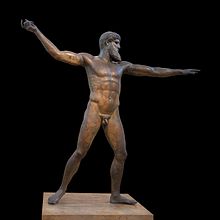
Examples of works made using the lost-wax casting process in Ancient Greece largely are unavailable due to the common practice in later periods of melting down pieces to reuse their materials.[31] Much of the evidence for these products come from shipwrecks.[32] As underwater archaeology became feasible, artifacts lost to the sea became more accessible.[32] Statues like the Artemision Bronze Zeus or Poseidon (found near Cape Artemision), as well as the Victorious Youth (found near Fano), are two such examples of Greek lost-wax bronze statuary that were discovered underwater.[32][33]
Some Late Bronze Age sites in Cyprus have produced cast bronze figures of humans and animals. One example is the male figure found at Enkomi. Three objects from Cyprus (held in the Metropolitan Museum of Art in New York) were cast by the lost-wax technique from the 13th and 12th centuries BC, namely, the amphorae rim, the rod tripod, and the cast tripod.[34]
Other, earlier examples that show this assembly of lost-wax cast pieces include the bronze head of the Chatsworth Apollo and the bronze head of Aphrodite from Satala (Turkey) from the British Museum.[35]

There is great variability in the use of the lost-wax method in East Asia. The casting method to make bronzes till the early phase of Eastern Zhou (770-256 BCE) was almost invariably section-mold process.[36] Starting from around 600 BCE, there was an unmistakable rise of lost-wax casting in the central plains of China, first witnessed in the Chu cultural sphere.[37] Further investigations have revealed this not to be the case as it is clear that the piece-mould casting method was the principal technique used to manufacture bronze vessels in China.[38] The lost-wax technique did not appear in northern China until the 6th century BC.[19] Lost-wax casting is known as rōgata in Japanese, and dates back to the Yayoi period, c. 200 BC.[16] The most famous piece made by cire perdue is the bronze image of Buddha in the temple of the Todaiji monastery at Nara.[16] It was made in sections between 743 and 749, allegedly using seven tons of wax.[16]
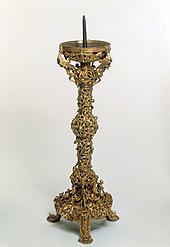
The Dunaverney (1050–910 BC) and Little Thetford (1000–701 BC) flesh-hooks have been shown to be made using a lost-wax process. The Little Thetford flesh-hook, in particular, employed distinctly inventive construction methods.[39][40] The intricate Gloucester Candlestick (1104–1113 AD) was made as a single-piece wax model, then given a complex system of gates and vents before being invested in a mould.[9]
The lost-wax casting tradition was developed by the peoples of Nicaragua, Costa Rica, Panama, Colombia, northwest Venezuela, Andean America, and the western portion of South America.[41] Lost-wax casting produced some of the region's typical gold wire and delicate wire ornament, such as fine ear ornaments. The process was employed in prehispanic times in Colombia's Muisca and Sinú cultural areas.[42] Two lost-wax moulds, one complete and one partially broken, were found in a shaft and chamber tomb in the vereda of Pueblo Tapado in the municipio of Montenegro (Department of Quindío), dated roughly to the pre-Columbian period.[43] The lost-wax method did not appear in Mexico until the 10th century,[44] and was thereafter used in western Mexico to make a wide range of bell forms.[45]

Some early literary works allude to lost-wax casting. Columella, a Roman writer of the 1st century AD, mentions the processing of wax from beehives in De Re Rustica, perhaps for casting, as does Pliny the Elder,[46] who details a sophisticated procedure for making Punic wax.[47] One Greek inscription refers to the payment of craftsmen for their work on the Erechtheum in Athens (408/7–407/6 BC). Clay-modellers may use clay moulds to make terracotta negatives for casting or to produce wax positives.[47] Pliny portrays[46] Zenodorus as a well-reputed ancient artist producing bronze statues,[48] and describes[46] Lysistratos of Sikyon, who takes plaster casts from living faces to create wax casts using the indirect process.[48]
Many bronze statues or parts of statues in antiquity were cast using the lost wax process. Theodorus of Samos is commonly associated with bronze casting.[46][49] Pliny also mentions the use of lead, which is known to help molten bronze flow into all areas and parts of complex moulds.[50] Quintilian documents the casting of statues in parts, whose moulds may have been produced by the lost wax process. Scenes on the early-5th century BC Berlin Foundry Cup depict the creation of bronze statuary working, probably by the indirect method of lost-wax casting.[51]
The lost-wax method is well documented in ancient Indian literary sources. The Shilpa Shastras, a text from the Gupta Period (c. 320–550 AD), contains detailed information about casting images in metal. The 5th-century AD Vishnusamhita, an appendix to the Vishnu Purana, refers directly to the modeling of wax for making metal objects in chapter XIV: "if an image is to be made of metal, it must first be made of wax."[15] Chapter 68 of the ancient Sanskrit text Mānasāra Silpa details casting idols in wax and is entitled Maduchchhista Vidhānam, or the "lost wax method".[15][16] The 12th century text Mānasollāsa, allegedly written by King Someshvara III of the Western Chalukya Empire, also provides detail about lost-wax and other casting processes.[15][16]
In a 16th-century treatise, the Uttarabhaga of the Śilparatna written by Srïkumāra, verses 32 to 52 of Chapter 2 ("Linga Lakshanam"), give detailed instructions on making a hollow casting.[15][16]
An early medieval writer Theophilus Presbyter, believed to be the Benedictine monk and metalworker Roger of Helmarshausen, wrote a treatise in the early-to-mid-12th century[52] that includes original work and copied information from other sources, such as the Mappae clavicula and Eraclius, De dolorous et artibus Romanorum.[52] It provides step-by-step procedures for making various articles, some by lost-wax casting: "The Copper Wind Chest and Its Conductor" (Chapter 84); "Tin Cruets" (Chapter 88), and "Casting Bells" (Chapter 85), which call for using "tallow" instead of wax; and "The Cast Censer". In Chapters 86 and 87 Theophilus details how to divide the wax into differing ratios before moulding and casting to achieve accurately tuned small musical bells. The 16th-century Florentine sculptor Benvenuto Cellini may have used Theophilus' writings when he cast his bronze Perseus with the Head of Medusa.[16][53]
The Spanish writer Releigh (1596) in brief account refers to Aztec casting.[16]